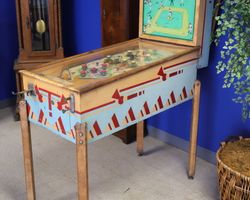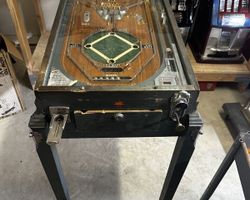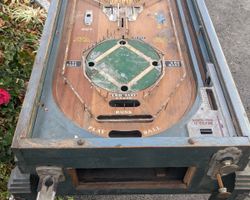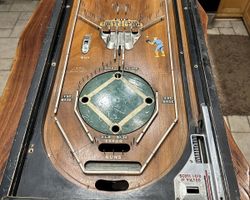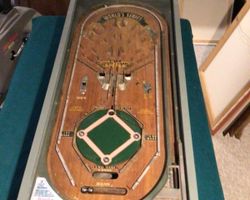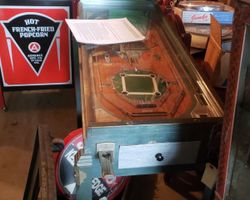World's Series
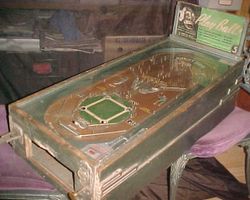
Average Prices: USD $600 to $1,900
Produced: May, 1934
Players: 1
Rock-ola Manufacturing Corporation's "World's Series," released in May 1934, stands as a testament to early pinball ingenuity, capturing the essence of America’s pastime through purely mechanical means. In an era predating electrified components and player-controlled flippers, this machine offered a sophisticated simulation of baseball, a design ambition that set it apart. Its creation coincided with a challenging economic period, showcasing Rock-ola's commitment to delivering engaging entertainment even with material constraints. The initial concept for the machine, then known as Rock-ola's 1934 'World's Series Champion Model,' first appeared at the February 1934 Coin Machine Expo in Chicago. This prototype featured chrome rails on its upper playfield. However, as actual production commenced, modifications were made. The chrome rails were replaced with an arrangement of pins, a strategic alteration aimed at reducing fabrication time and material costs. This refined version, simply titled "World's Series," became the model that entered mass production. Furthermore, the production models integrated patent numbers—Design Patent DE90,927, Ball Shooter Patent 1,842,863, and Mechanical Patent 1,975,374—directly onto the middle playfield, details absent from the earlier expo model. These patents highlight the innovative spirit behind its design and mechanical operation. The machine’s production run was substantial for its time, exceeding 50,000 units, indicating its widespread appeal and commercial success, and solidifying Rock-ola's position in the nascent coin-operated game industry.
Signature Features and Design
The defining characteristic of "World's Series" is its ingenious rotating bases mechanism, a purely mechanical marvel that serves as the core of its baseball simulation. Unlike later machines that relied on electrical circuits for complex actions, every aspect of "World's Series"—from ball launch to scoring—operates through intricate mechanical linkages. The playfield visually represents a baseball diamond, with specific targets designated for hits, balls, and strikes. What truly sets this game apart is the way it simulates player progression on the bases. As a player achieves a "hit," a ball visually "runs" the bases, progressing from home plate to first, then second, and so on. This is achieved by the rotating bases system, which cleverly changes position with each consecutive successful hit, allowing for a tangible representation of runners advancing and scoring runs. The absence of electricity and flippers necessitates a design centered on precise shot aiming and understanding ball physics, making the game a challenge of skill rather than luck. The machine’s art, while not as vibrant as later hand-drawn backglasses, effectively communicates its baseball theme through direct, clear graphics and a straightforward playfield layout that guides the player's eye towards the baseball diamond at its heart.
Playfield and Mechanics
The "World's Series" playfield is a masterclass in mechanical design, prioritizing functional representation of the baseball theme. The upper section of the playfield is dominated by an arrangement of pins, which replaced the chrome rails seen in the earlier prototype. These pins strategically influence ball trajectories, directing the ball towards various targets that register as hits, balls, or strikes. Below this, the middle playfield prominently displays the machine's various patent numbers, a subtle nod to its mechanical sophistication. The core of the gameplay unfolds on the lower half, where the baseball diamond is represented. Major "shots" on the playfield are not through ramps or targets in the modern sense, but rather specific zones or pathways where the ball must travel to register an event. Hitting certain areas could advance a "runner" (represented by the rotating bases) or trigger an "out." The design philosophy behind this layout was to create a fluid, intuitive representation of a baseball game without relying on electronic feedback. The lighting, rudimentary by today's standards, likely served to illuminate key areas and scoring indicators, enhancing player visibility. The overall aesthetic is one of robust mechanical craftsmanship, where the elegance lies in the intricate interplay of gears, levers, and springs that bring the baseball simulation to life.
Gameplay Dynamics
"World's Series" offers a distinctive gameplay experience rooted entirely in its mechanical brilliance. Players are typically given 15 balls per game, with the objective of scoring as many runs as possible before accumulating three "outs." The scoring system is directly tied to the baseball metaphor: advancing runners around the bases and bringing them home registers as a run. Each successful shot that results in a "hit" triggers the highly praised rotating bases mechanism, advancing a figurative runner. For instance, hitting a single might advance a runner from home to first base; another hit might move them to second. The game dynamically keeps track of "balls" and "strikes" as well, adding another layer of strategic depth that mirrors real baseball. The objective is to achieve a sequence of hits that allows runners to score, while avoiding "outs" that end the inning or game. One of the unique aspects of its gameplay lies in its transition of pinball from a simple game of chance to one requiring a degree of player skill, primarily through precise ball launching and nudging. While the gameplay is beautifully simple in concept, the pure mechanical nature means achieving a high score, such as the reported 13 runs (out of a perfect 15), demands exceptional control and understanding of the machine's physics. Early designs presented a potential imbalance where "walks" could be randomly awarded as hits, sometimes even home runs, though this randomizer could be disabled for more consistent and skill-driven play.
Reception and Legacy
"World's Series" by Rock-ola has garnered consistent praise from pinball enthusiasts for its ingenuity and lasting appeal. Its greatest strength lies in the inventive rotating bases mechanism, frequently cited as a remarkable achievement in purely mechanical game design. Players often express admiration for how such a complex and engaging baseball simulation was achieved without any electrical components or flippers, relying solely on springs, levers, and gravity. This mechanical purity is celebrated, with the game often placed alongside other highly regarded mechanical machines for its cleverness and addictive quality. The successful abstraction of baseball rules—managing balls, strikes, and outs, and advancing runners—through such a system is a frequent point of commendation. Reviewers note its transition of pinball from a mere "marble game" to one demanding skill, making it a pivotal design in the evolution of the industry. Despite its age, many find its gameplay surprisingly engaging, appreciating the challenge and satisfaction of mastering a purely mechanical interface. The primary weakness noted in feedback relates to a potential for randomness where unintended "walks" might be awarded as hits, disrupting the skill-based flow, though this was not a universal experience and could be modified. "World's Series" holds a significant place in pinball history, not just for its high production numbers, but as a demonstration of what was possible through mechanical innovation during a period of rapid industry growth. Its influence can be seen in subsequent sports-themed pinball machines, setting a standard for how a complex real-world game could be distilled into a compelling tabletop experience. It stands as a testament to the creativity and engineering prowess of its era, admired for its elegance and the sheer mechanical artistry involved in its creation.
Sponsored Links
 Ebay Listings
Ebay Listings
 Auction Results
Auction Results
| Cost | Location | Date |
|---|---|---|
| USD $2,000 |  Ohio, United States Ohio, United States |
30 October, 2024 |
| USD $1,795 |  California, United States California, United States |
13 March, 2024 |
| USD $300 |  Pennsylvania, United States Pennsylvania, United States |
12 March, 2024 |
| USD $980 |  United States United States |
17 January, 2023 |
| USD $700 |  United States United States |
18 November, 2022 |
| USD $750 |  California, United States California, United States |
29 January, 2020 |
| USD $1,395 |  Minnesota, United States Minnesota, United States |
13 March, 2019 |
| USD $550 |  Wisconsin, United States Wisconsin, United States |
29 October, 2018 |
| USD $2,000 |  Kentucky, United States Kentucky, United States |
09 September, 2018 |
| USD $660 |  Minnesota, United States Minnesota, United States |
21 April, 2018 |


Private Policy · Search Website · Contact Us
As an eBay Partner, we may earn a commission from qualifying purchases made through links on this site, at no additional cost to you.
All trademarks and copyrighted materials remain property of their respective owners. All other content copyright 2007 - 2025 Pinpedia.

